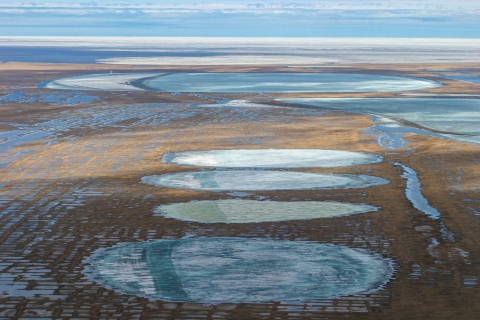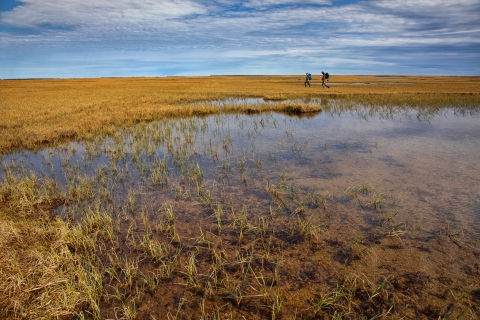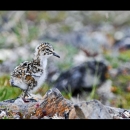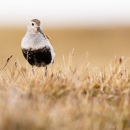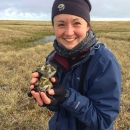States
AlaskaEcosystem
Coastal, Tundra, WetlandOverview
Working together with Manomet, Inc., the U.S. Geological Survey, Bureau of Land Management, Alaska Fish and Game Department, and others, we conduct extensive shorebird surveys throughout Alaska as part of the Program for Regional and International Shorebird Monitoring (PRISM). This work was initiated in 1998 and has included most of the Arctic Coastal Plain and the Yukon Delta National Wildlife Refuge in western Alaska. Recently we began repeating these surveys, with surveys conducted in the Arctic National Wildlife Refuge (2019, 2022) and the eastern portion of the National Petroleum Reserve - Alaska (NPR-A) in the Teshekpuk Lake Special Area (TLSA, 2023 and 2024). Current plans are to survey the central NPR-A (2025), western NPR-A (2026), and state lands between the Colville and Canning rivers (206,2027). PRISM’s primary goal is to estimate the size of shorebird breeding populations in North America. To do this, biologists visit randomly located plots with a helicopter and then drop ground crews off to walk over the tundra and count birds. These data when analyzed provide the size and trends of shorebird populations and when compared with past population estimates in the same area provide trends of shorebird populations. This survey also provides information on the distribution and habitats used by different shorebird species, which helps managers understand what areas are most important to shorebirds, allowing them to meet their shorebird conservation goals, and provide recommendations for mitigating any proposed developments, like oil and gas, mining, and road construction.
Teshekpuk Lake is the largest lake on the Arctic Coastal Plain of Alaska. The TLSA in the NPR-A supports some of the highest densities of breeding shorebirds (and other arctic-nesting birds) in the entire Arctic. This area is critically important for birds, caribou, brown bears, a diversity of other wildlife. Shorebirds are one of the most abundant and most threatened groups of birds on the Arctic Coastal Plain of Alaska. Migration surveys in other parts of the United States suggest shorebirds are declining, but these surveys have low precision, and we need more accurate population estimates and trend information to guide management actions. Unlike waterfowl, breeding shorebirds cannot be counted by aerial surveys, and annual surveys on the ground of all or a large portion of northern North America would be prohibitively expensive. PRISM was created to address these challenges, by relying on surveys once every 15 years – a time frame that allows funds to be raised to conduct surveys but also provided meaningful trend data. Surveys in the Arctic National Wildlife Refuge and the TLSA have now been repeated, and in both incidences declines in shorebird numbers have been observed. These results affirm the declines in populations observed on the migration areas in other parts of the United States.
In addition to conducting traditional PRISM surveys, we are also testing methods for using autonomous recording units (ARUs) to denote the vocalizations of birds as an alternative way to detect birds within our survey plots. The ARUs can collect data throughout the summer, potentially increasing the likelihood of birds being detected, and negate the expensive cost of having field crews based in remote regions. However, not all birds vocalize and determining density of birds from vocalizations has challenges. Over the nest few years, acoustic ecologists will compare traditional PRISM and acoustic PRISM results to determine if this alternative method is cost effective and an appropriate alternative to humans counting birds on the land.
Importance of this Work
We know that many of our North American shorebird species are declining, but we don’t have a lot of information about their population sizes and trends. One of the few ways to determine how much a population is declining is to do surveys during the breeding season, when populations are fixed in space and time. Shorebirds are distributed over large landscapes in their breeding surveys, which can be difficult to access. To be successful, we must work collaboratively across their habitats to survey and monitor this imperiled group of birds. To accomplish this project, we rely on additional help and funding from federal grants and other organizations including non-profits, universities, and other agencies.
Actions WE ALL can take
Giving them Space. Beach/coastal walking, a seemingly harmless activity, can have negative consequences on shorebirds that are using the area for rest, foraging, or nesting. In some parts of the U.S., human disturbance is one of the most significant threats to shorebird populations. These threats can intensify as human use (coastal recreation, off-leash dogs) in these coastal areas increases, leading to an overall reduction in suitable, undisturbed habitats for shorebirds.
If you are recreating near a coastline, shoreline, or other wetland type used by shorebirds, please give the shorebirds space—ideally, do not approach within 200 m (656 ft.). If you are recreating with a dog, please keep your dog leased, as the presence of dogs is directly related to shorebirds expending more energy being alert to their presence. If you are located in Anchorage, the municipal law requires you to restrain your dog in public places unless you are in a designated off-lease dog park. Learn more about how leashing your dogs protects birds from the National Audubon Society.
Participating in citizen science. Anyone can contribute valuable data by submitting what they see to citizen science programs like eBird or becoming an International Shorebird Survey volunteer. Shorebirds lend themselves to being quite visible outside the breeding season, congregating in large flocks and utilizing visible habitats like beaches and shorelines. Casual bird sightings can be a valuable data points for scientists. By submitting your bird sightings to eBird, or participating in the International Shorebird Survey you can play a crucial role in helping scientists monitor shorebirds.
Spreading the Word: Share information about shorebirds and their threats with your family, friends, and neighbors. Talk to them about how sustained public support are crucial to ensure the future of this group of birds.

